Janggyeongpanjeon Depositories of Haeinsa Temple (Designated 1995)
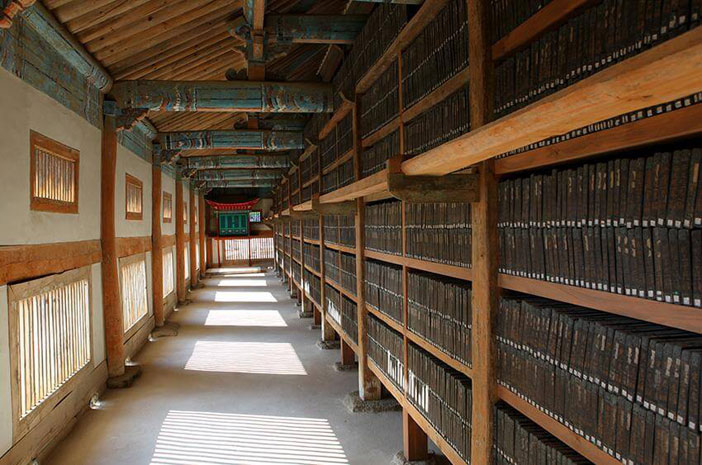 【 Photo: Inside view of Haeinsa Temple Janggyeongpanjeon Depositories 】
【 Photo: Inside view of Haeinsa Temple Janggyeongpanjeon Depositories 】 Haeinsa Temple's Janggyeongpanjeon Depositories is an official archive built to safely store the 13th-century Printing Woodblocks of the Tripitaka Koreana and Miscellaneous Buddhist Scriptures, a UNESCO Memory of the World Register item. The hall is believed to have been built in the 15th century, which makes it all the more amazing for its scientifically advanced construction. The hall was built in such a way as to perfectly preserve and protect the fragile woodblocks from changes in the temperature and humidity levels.
- Nearby attractions
Gayasan National Park (Hongnyudong, Cheongnyangdong Area)
Yeonhosa Temple
Okgyeseowon Confucian Academy
Cheongnyangsa Temple
Hambyeongnu Pavilion - Website: www.haeinsa.or.kr (Korean only)
- 1330 Korea Travel Hotline: +82-2-1330 (Korean, English, Japanese, Chinese, Russian, Vietnamese, Thai, Malay)
Jongmyo Shrine (Designated 1995)
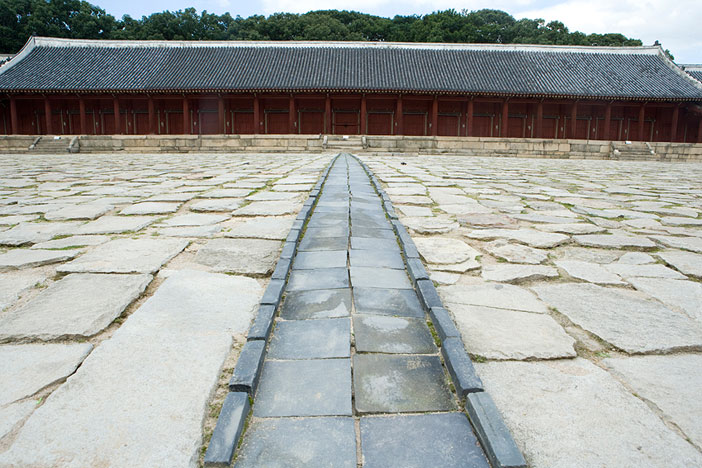 【 Photo: Jeongjeon Hall in Jongmyo Shrine 】
【 Photo: Jeongjeon Hall in Jongmyo Shrine 】 Jongmyo Shrine in Jongno-gu, Seoul is the royal shrine interred with the ancestral tablets of Joseon dynasty’s royal family. Memorial services for the kings and queens were held here to pray for the safety of the country and its people; the rites also served to enforce the legitimacy of the royal family. The building itself has the greatest religious implications from a Confucian perspective, showing reverence and respect in every aspect of its construction.
First built around the end of the 14th century, the current Jongmyo Shrine is a reconstruction built in the 17th century after the Imjin War (1592-1598). The main building is Jeongjeon Hall, an impressively long, wooden structure that stands in good harmony with the courtyard and auxiliary buildings. The unique atmosphere is one-of-a-kind, found nowhere else in Asia, let alone Western nations.
Following the Confucian culture of honoring one’s ancestors, a ceremony known as Jongmyo Jerye is held for the royal family of the Joseon period within the site. The buildings along with intangible heritages of rituals, music, dancing and food are all protected at Jongmyo Shrine, making it a veritable cultural asset.
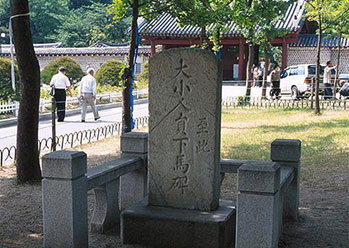 【 Photo: Hamabi Monument at Jongmyo 】
【 Photo: Hamabi Monument at Jongmyo 】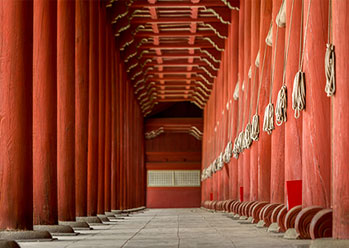 【 Photo: Pillars of the Main Hall 】
【 Photo: Pillars of the Main Hall 】
Before the main entrance of Jongmyo Shrine are hamabi, commandment stones indicating that anyone who passes by should get off his horse as a form of respect to the ancestors. Even the kings and queens were required to get down from their palanquins in order to pay their respects to the former rulers.
Jeongjeon Hall, Jongmyo Shrine's main hall, is the longest wooden structure in Korea. The front facade features 20 pillars with doors in the spaces between. While the outside of the structure is rather plain, the interior is elaborately decorated for the pleasure of the ancestors' spirits. Visitors cannot enter Jeonjeon Hall, but can get an idea by viewing a replica in Exhibition Hall 2 of Hyangdaecheong Hall.
There are three main gates to Jeonjeon Hall, located on the east, west and south sides. The path located to the south is reserved for the royal spirits and thus no living soul is allowed to step foot on it. The two other gates are for mortals: the east gate was for the king and crown prince while the west gate was for musicians and dancers performing at the memorial ceremony.
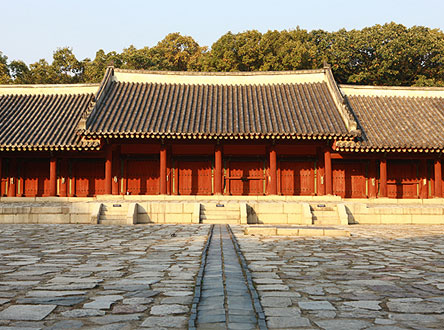 【 Photo: Yeongnyeongjeon Hall 】
【 Photo: Yeongnyeongjeon Hall 】 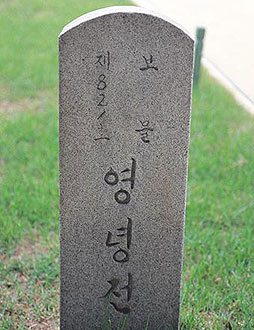 【 Photo: Yeongneyongjeon
【 Photo: Yeongneyongjeon
tablet stone 】
Jeongjeon Hall was too small to hold all of the ancestral tablets, so Yeongnyeongjeon Hall, meaning "Hall of Eternal Comfort," was built as an annex building. Compared with the main hall, Yeongnyeongjeon Hall is smaller and holds fewer tablets. One distinctive feature is that the annex has a taller roof section at the center, while Jeongjeon Hall has an uninterrupted roofline. Yeongnyeongjeon Hall holds the tablets of kings and queens whose reign was either rather short or who were recorded with no notable achievements.
- Nearby attractions
Gyeongbokgung Palace
Changdeokgung Palace and Huwon
Deoksugung Palace
Changgyeonggung Palace
Gwanghwamun Square
Seoul Museum of History - Website: jm.cha.go.kr (Korean, English, Japanese, Chinese)
- 1330 Korea Travel Hotline: +82-2-1330 (Korean, English, Japanese, Chinese, Russian, Vietnamese, Thai, Malay)
Seokguram Grotto and Bulguksa Temple (Designated 1995)
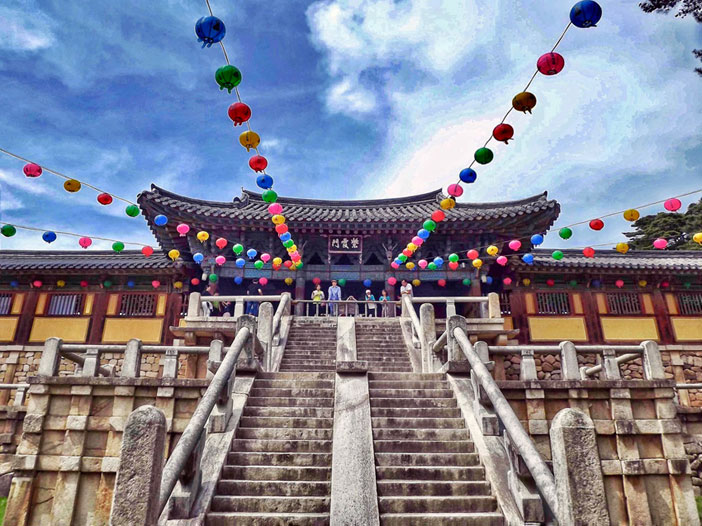 【 Photo: Bulguksa Temple 】
【 Photo: Bulguksa Temple 】 Seokguram Grotto and Bulguksa Temple are ancient Buddhist temples of Korea, which were established in the mid-8th century during the golden era of the Unified Silla dynasty. These two heritages represent the highly developed architectural skills and creative craftsmanship of the Silla people. In particular, the magnificent and sublime beauty of Seokguram’s carvings and Bulguksa Temple’s stylobate and its two stone pagodas are considered masterpieces of Buddhist architecture, unparalleled in all of Northeast Asia.
Seokguram Grotto is an artificial cave made of granite. Inside the round-shaped main hall is the statue of Bonjon Buddha, surrounded by disciples on the walls. The majority of the stone statues, including the Bonjon Buddha statue, are highly valued as cultural heritages for having survived the passage of time with the original structure still intact since the 8th century.
Bulguksa Temple, literally translating to “Temple of the Land of Buddha,” was built with the aspiration for Buddha’s utopia. The temple was damaged in 1592 during the Imjin War, when all the wooden structures of the temple completely burned down. The stone altars, bridges, pagodas, lanterns and bronze statues of Buddha escaped the fire, and have been well preserved. A partial restoration was conducted from 1969 to 1973, which resulted in the current temple state.
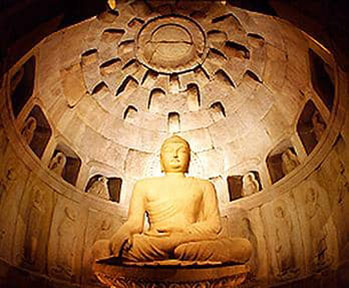 【 Photo: Seokguram Grotto 】
【 Photo: Seokguram Grotto 】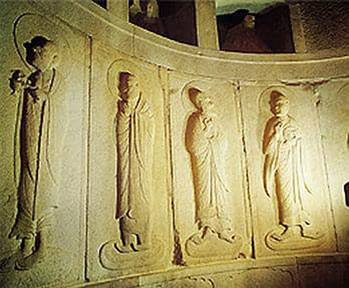 【 Photo: Relief of 10 disciples 】
【 Photo: Relief of 10 disciples 】
While most Buddha statues at the time were carved in a standing position wearing a generous smile, the Bonjon Buddha is seated on a pedestal, emanating a sense of grandeur. A noteworthy point at Seokguram Grotto is the rare relief of ten disciples. It is highly appreciated for its uniqueness and artistic characteristics.
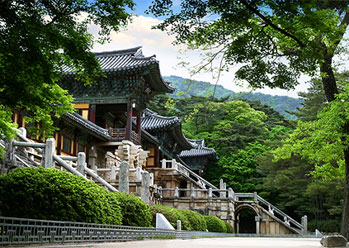 【 Photo: Exterior of Bulguksa Temple 】
【 Photo: Exterior of Bulguksa Temple 】 【 Photo: Dabotap Pagoda 】
【 Photo: Dabotap Pagoda 】
Bulguksa Temple's Seokgatap Pagoda is located on the western side of the Daeungjeon Hall. Also called Muyeongtap, it has two stereobates (stone foundation levels) and was crafted in the traditional pagoda style of the Silla period. Dabotap Pagoda, standing on the east side of the yard, was distinctively different from other stone pagodas of the Silla era, and has remained completely intact since its construction. At the time of their construction, most temples had identical pagodas, so the fact that Dabotap and Seokgatap Pagodas are different is a unique aspect to Bulguksa Temple.
- Nearby attractions
Gyeongju Yangdong Village
Gyeongju Historic Area
Cheomseongdae Observatory
Bunhwangsa Temple
Daereungwon Ancient Tomb Complex (Cheonmachong Tomb)
Gyeongju Donggung Palace and Wolji Pond
Gyeongju Gyochon Traditional Village
Gyeongju Poseokjeong Pavilion Site - Website: www.gyeongju.go.kr (Korean, English, Japanese, Chinese)
- 1330 Korea Travel Hotline: +82-2-1330 (Korean, English, Japanese, Chinese, Russian, Vietnamese, Thai, Malay)
Changdeokgung Palace Complex (Designated 1997)
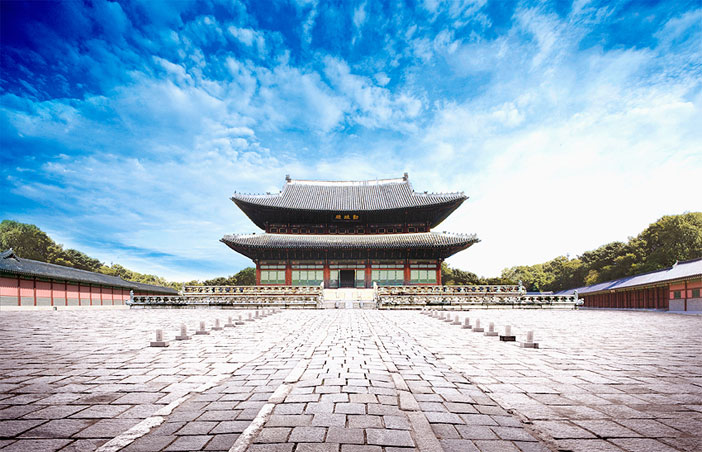 【 Photo: Injeongjeon Hall of Changdeokgung Palace 】
【 Photo: Injeongjeon Hall of Changdeokgung Palace 】 Changdeokgung Palace is from the Joseon dynasty (1392-1910), built in harmony with the natural environment around it. The palace is famous for its rear garden, also called Huwon. The vast garden was a resting place for the royal family and is beautifully landscaped in a way that held on to the original nature of the space. Of all the royal palaces, Changdeokgung Palace is the most well-preserved to this day, showcasing the creativity of Korean palace construction through the combination of buildings and nature. In harmony with the trees, ponds, pavilions and flower gardens, the palace's main structures include Injeongmun Gate, Injeongjeon Hall, Huijeongdang Hall, Daejojeon Hall, Buyongji Pond, Nakseonjae Hall and Donhwamun Gate.
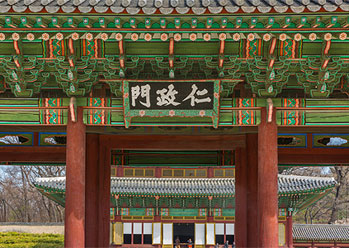 【 Photo: Injeongmun Gate 】
【 Photo: Injeongmun Gate 】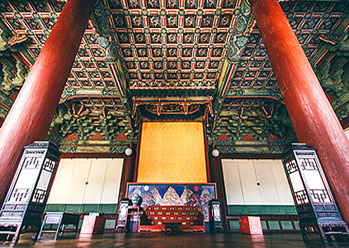 【 Photo: Interior of Injeongjeon Hall 】
【 Photo: Interior of Injeongjeon Hall 】
Injeongmun Gate is the main gate leading into Changdeokgung Palace and its courtyard where Injeongjeon Hall is located. With a name meaning “benevolent rule,” Injeonjeon Hall was used for matters relating to the king’s ruling of the nation as well as for conducting state affairs, including the proclamation of a new crown prince and royal weddings. Therefore this hall is by far the most important of all the buildings in Changdeokgung Palace.
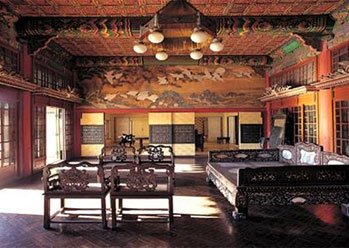 【 Photo: Daejojeon Hall 】
【 Photo: Daejojeon Hall 】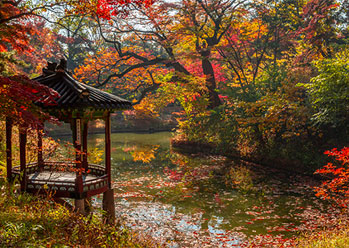 【 Photo: Huwon Garden 】
【 Photo: Huwon Garden 】
Daejojeon Hall, the residence of the queen, was built with Western features, including a narrow wooden veranda, glass windows, and Western-style furniture. This modern interior design makes Daejojeon Hall unique among palace buildings.
The royal garden is located north of the main palace area. Serving in various ways depending on the circumstances, the Huwon was most often used as a relaxing space for the king. The garden is home to trees planted hundreds of years ago, and small pavilions and fountains complete the traditional Korean-style garden. In order to preserve the historical integrity of the Huwon, visitors must sign-up for the guided Huwon tour in advance.
- Nearby attractions
Bukchon Hanok Village
Samcheongdong-gil Road
Gwanghwamun Gate
Cheonggyecheon Stream
Insa-dong
Naksan Park - Website: www.cdg.go.kr (Korean, English)
- 1330 Korea Travel Hotline: +82-2-1330 (Korean, English, Japanese, Chinese, Russian, Vietnamese, Thai, Malay)
Hwaseong Fortress (Designated 1997)
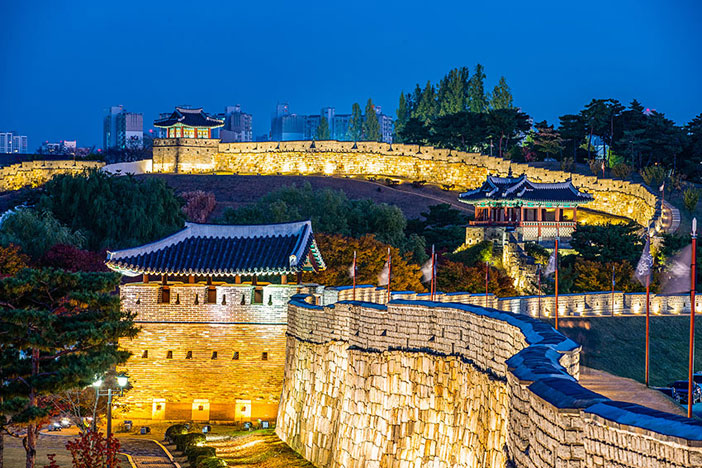 【 Photo: Hwaseong Fortress 】
【 Photo: Hwaseong Fortress 】 Hwaseong Fortress, located in Suwon, Gyeonggi-do, is a living remnant of the nation’s proud history, representing the Joseon dynasty of the 18th century. The fortress was built by King Jeongjo, Joseon’s 22nd king, whose aim was to create a new city honoring his father, Crown Prince Jangheon, after relocating his father’s tomb to the area.
Suwon Hwaseong Fortress was built with an entirely new method, making it unlike any other fortress in Korea. The construction methods encompassed the strong points of both Asian and Western elements together. In addition, the fortress was built in good harmony with the surrounding nature, implementing its geological advantage wisely for strategic defense rather than destroying it. The fortress is a symbol of both the ingenuity and technological advancements of the period. Thanks to this, in addition to the beautiful layout and dynamic defense facilities, UNESCO enlisted Hwaseong Fortress on the World’s Cultural Heritage List in 1997.
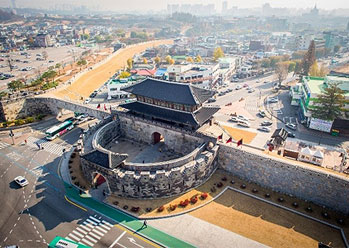 【 Photo: Paldalmun Gate 】
【 Photo: Paldalmun Gate 】 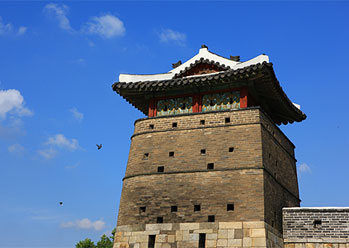 【 Photo: Northwestern Watchtower 】
【 Photo: Northwestern Watchtower 】
Paldalmun Gate is the southern gate of Hwaseong Fortress's four main gates. Designated as a Treasure, it has maintained its original structure since the time of its first construction. This gate is unique in that it is detached from the rest of the fortress wall, providing additional protection. Among all of the cultural relics of Hwaseong Fortress, none is as famous as Paldalmun Gate, which boasts a mesmerizing scene after sunset.
The Northwestern Watchtower of Hwaseong Fortress is another important structure, designated as a Treasure. Made with bricks, it served as a major guard point, defending against attacks from Hwaseomun Gate's direction. The walls feature arrow-slots, something found nowhere else in Korea, to give soldiers a built-in shield as they shot firearms and canons through the holes.
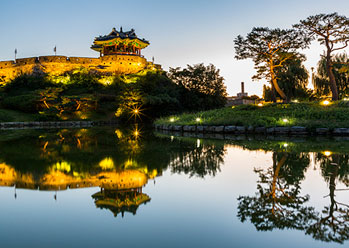 【 Photo: Banghwasuryujeong Pavilion 】
【 Photo: Banghwasuryujeong Pavilion 】 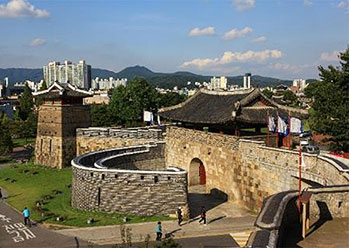 【 Photo: Hwaseomun Gate 】
【 Photo: Hwaseomun Gate 】
Banghwasuryujeong Pavilion, sitting above Yongyeon Pond, functioned as a strategic military position while also providing views of the beautiful scenery. The pavilion is unique in that it is the only two-story pavilion built with a mix of stone, wood, and brick.
Hwaseomun Gate is the western gate of the fortress, and previously served as the major route connecting the center of Suwon with Namyangman Bay and the western coast. Designated as a Treasure, this gate features an ongseong (crescent-shaped wall) with a slight opening on one side.
- Nearby attractions
Temporary Palace at Hwaseong Fortress
Suwon Hwaseong Museum
Suwonhyanggyo Confucian School
Wolhwawon Garden - Website: www.swcf.or.kr (Korean, English, Japanese, Chinese)
- 1330 Korea Travel Hotline: +82-2-1330 (Korean, English, Japanese, Chinese, Russian, Vietnamese, Thai, Malay)
Gochang, Hwasun and Ganghwa Dolmen Sites (Designated 2000)
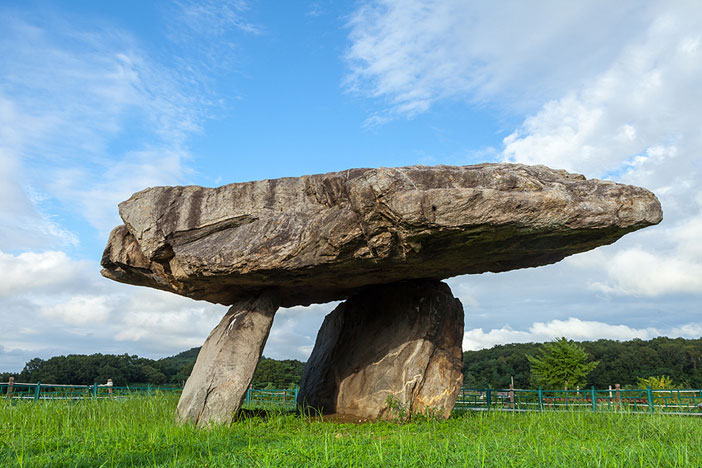 【 Photo: Dolmen in Bugeun-ri, Ganghwa 】
【 Photo: Dolmen in Bugeun-ri, Ganghwa 】Dolmens, stone graves that were built in the prehistoric era, dot the areas of Gochang Dolmen Site, Hwasun Dolmen Site and Ganghwa Dolmen Site. These three regions are unparalleled in the world, given the degree of concentration and diversity in the forms and scales of dolmens discovered here. Most of the dolmens were built in 1000 BC, providing modern people with a glimpse into the society and technological advancement of the period.
Recognized by UNESCO in 2000, dolmens in Gochang, Hwasun, and Ganghwa are considered the finest artifacts for studying the social structure of Korea in the Bronze Age and cultural exchanges with people in Northeastern Asia during the Prehistoric Era. In particular, the remaining quarries are considered valuable materials for understanding the construction process as well as history and transformation of dolmens.
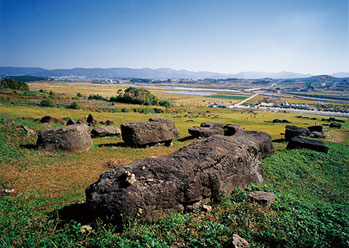 【 Photo: Gochang Dolmen Site 】
【 Photo: Gochang Dolmen Site 】 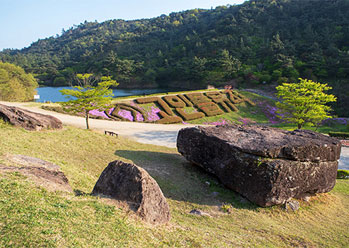 【 Photo: Hwasun Dolmen Site 】
【 Photo: Hwasun Dolmen Site 】
Gochang Dolmen Site has one of the largest concentrations of dolmen in Korea; there were around 1,600 dolmens discovered in the area as of 2009. Of the many dolmens, 447 of Gochang’s dolmens were officially registered with UNESCO.
Hwasun Dolmen Site is spread throughout a 10 kilometer-long mountain valley linking Hyosan-ri and Daesin-ri. The site has a total of 596 dolmens, usually found at the foot of the mountain or on the rocky mountain tops. Being located in areas difficult for humans to access, the dolmens have remained nearly perfectly preserved.
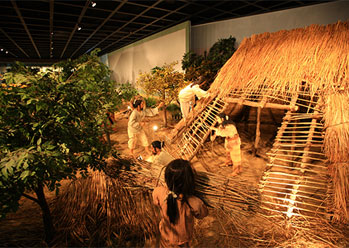 【 Photo: Gochang Dolmen Museum 】
【 Photo: Gochang Dolmen Museum 】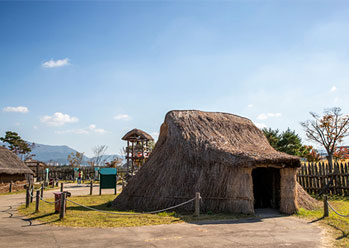 【 Photo: Dugout hut at Ganghwa Dolmen Site 】
【 Photo: Dugout hut at Ganghwa Dolmen Site 】
There are over 150 dolmens remaining from the Bronze Age at Ganghwa Dolmen Site. The distribution of dolmens here is spread widely throughout regions of diverse topographical features, indicating the difference in living conditions and the time of their construction. The most representative dolmen in the region is the Dolmen in Bugeun-ri, a table-styled dolmen with a huge cover stone resting on two supporting stones.
- Nearby attractions
Gochangeupseong Walled Town
Seonunsan Provincial Park
Munsusa Temple (Gochang)
Dinosaur Tracksite of Hwasun, Seoyu-ri
Unjusa Temple
Manisan Mountain
Jeondeungsa Temple
- Website: www.gochang.go.kr/tour (Korean, English, Japanese, Chinese)
- 1330 Korea Travel Hotline: +82-2-1330 (Korean, English, Japanese, Chinese, Russian, Vietnamese, Thai, Malay)
Gyeongju Historic Areas (Designated 2000)
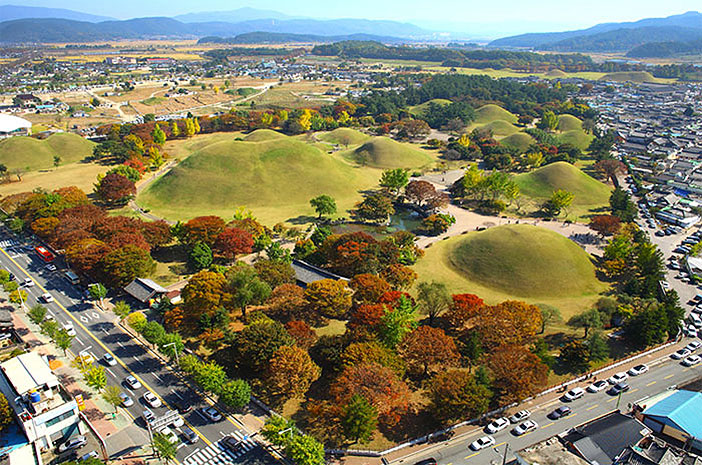 【 Photo: Aerial of Daereungwon Tomb Complex 】
【 Photo: Aerial of Daereungwon Tomb Complex 】 Gyeongju Historic Area is a historical attraction where the achievements and culture of the Silla dynasty (57 BC – AD 935) have remained well-preserved through pagodas, tombs, fortresses, and more. Serving as the capital city of Silla for nearly 1,000 years, Gyeongju perfectly showcases Korean architecture and Buddhist culture. The area is divided into 5 zones based on their characteristics: the Namsan Mountain area, a center of Buddhist culture; the Wolseong Fortress area, the royal grounds of the Silla dynasty; the Daereungwon Ancient Tomb area, the tombs of high-ranking officials including the kings of the Silla dynasty; the Hwangnyongsa Temple area, showing the essence of Silla Buddhism; and the Sanseong Fortress area, focusing on the defense system of the royal capital.
The most representative heritages include Gyeongju Poseokjeong Pavilion Site, Rock-carved Bodhisattva at Sinseonam Hermitage in Namsan Mountain, Donggung Palace & Wolji Pond, Cheomseongdae Observatory, Ancient Tombs in Hwangnam-ri, Daereungwon Ancient Tomb Complex, Hwangnyongsa Temple Site and Bunhwangsa Temple.
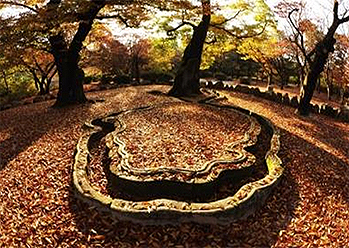 【 Photo: Gyeongju Poseokjeong Pavilion Site 】
【 Photo: Gyeongju Poseokjeong Pavilion Site 】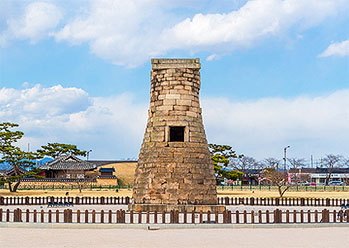 【 Photo: Cheomseongdae Observatory 】
【 Photo: Cheomseongdae Observatory 】
Poseokjeong Pavilion Site is located at a detached palace of the Silla dynasty in a valley on the western side of Gyeongju’s Namsan Mountain. The site features a stone waterway carved into a raised rock platform, where it is said that guests would float their drinking glasses. Through this site, we can see the Silla people's love for a cozy and relaxing atmosphere.
Constructed during the reign of Queen Seondeok (r. 632-647), Cheomseongdae Observatory was used for observing the stars. It is the oldest existing astronomical observatory in Asia. Astronomy was very important in relation to agriculture as the movement of the stars could influence the farming schedule. The observatory is also highly valued as proof of the advanced science and technology of the Silla dynasty.
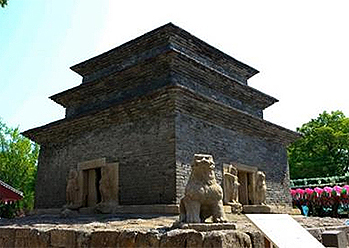 【 Photo: Stone Brick Pagoda of Bunhwangsa Temple 】
【 Photo: Stone Brick Pagoda of Bunhwangsa Temple 】 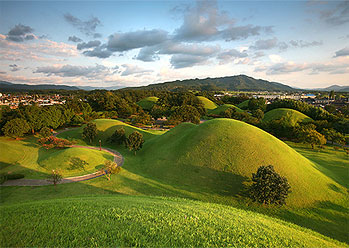 【 Photo: Daereungwon Tomb Complex
【 Photo: Daereungwon Tomb Complex
(Cheonmachong Tomb) 】
Bunhwangsa Temple was where Silla’s prominent Buddhist priest Wonhyo resided. The stone brick pagoda in front of the temple has become one of the must-see sites in Gyeongju, as nothing like it can be seen at other temples. It is the oldest stone pagoda remaining from the Silla period. The building structure is unique, as are the stones used, which were shaped to resemble bricks.
Of all the large ancient tombs of kings and nobles of the Silla Kingdom seen at Daereungwon Ancient Tomb Complex, Cheonmachong Tomb is the only tomb open to the public. During an excavation, a painting of a heavenly horse was discovered within the tomb, giving it the name Cheonmachong (“cheonma” means heavenly horse in Korean). There are over 10,000 remains and relics inside the tomb, providing excellent resources for the study of ancient art and the exchange of culture among nations.
- Nearby attractions
Seokbinggo (Stone Ice Storage)
Gyeongju Gyochon Traditional Village
Gyeongju Namsan Mountain
Seokguram Grotto
Bulguksa Temple
Gyeongju Donggung Palace and Wolji Pond - Website: www.gyeongju.go.kr (Korean, English, Japanese, Chinese)
- 1330 Korea Travel Hotline: +82-2-1330 +82-2-1330 (Korean, English, Japanese, Chinese, Russian, Vietnamese, Thai, Malay)
Royal Tombs of the Joseon Dynasty (Designated 2009)
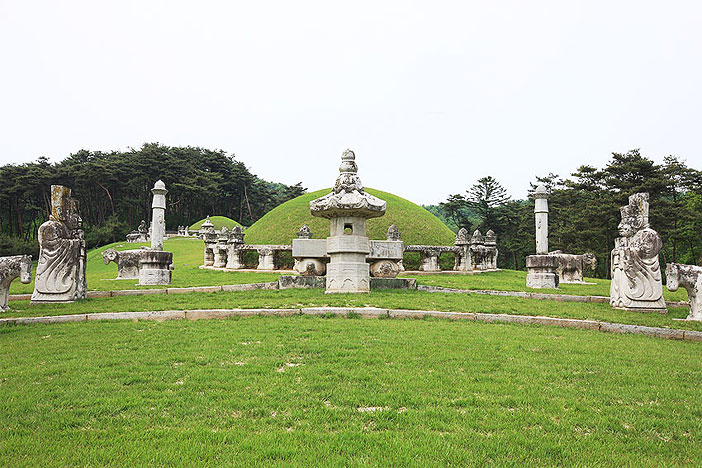 【 Photo: Yeoju Yeongneung Royal Tomb 】
【 Photo: Yeoju Yeongneung Royal Tomb 】 Royal tombs of the Joseon dynasty are heritage sites from the 5th century that are invaluable to Korea's history. The royal tombs are well-preserved to this day in accordance with Korea's traditional values based on Confucianism and finding harmony with nature. UNESCO has appointed the areas and ancestral rites held on the sites as World Cultural Heritages so they can be remembered and cherished for their unique beauty and cultural importance.
Because of a law stating that royal tombs could not be located far from Seoul, called Hanyang at the time, most of the royal tombs from the Joseon dynasty are located around the city. As a result, a number are found in the capital city of Seoul, including Seolleung and Jeongneung Royal Tombs, Jeongneung and Uireung Royal Tombs; West Five Royal Tombs, East Nine Royal Tombs, Gwangneung Royal Tomb, Yungneung and Geolleung Royal Tombs and Yeongneung and Nyeongneung Royal Tombs in Gyeonggi-do. Jangneung Royal Tomb is unique for its location in Gangwon-do.
 【 Photo: Seolleung Royal Tomb 】
【 Photo: Seolleung Royal Tomb 】 【 Photo: Yeongneung Royal Tomb 】
【 Photo: Yeongneung Royal Tomb 】
Seonjeongneung is the joint name for the site of Seolleung and Jeongneung Royal Tombs. Located in Samseong-dong, Gangnam, Seonjeongneung is the burial site of King Seongjong (1469-1494), his wife Queen Jeonghyeon, and their son King Jungjong (1488-1544). Also called Samneung Park, the area is well maintained despite being located in the middle of the busy city, and is an important cultural heritage.
Yeongneung, in Yeoju, Gyeonggi-do, was the first joint royal tomb of the Joseon dynasty, and houses the 4th ruler of the Joseon dynasty, King Sejong (1397-1450) the Great, who is respected for the invention of Hangeul (Korean language), and his wife Queen Soheon. King Sejong, who ruled for 32 years, left behind an impressive legacy, including producing the Hunminjeongeum Manuscript, or “The Proper Sounds for the Instruction of the People,” to spread knowledge of Hangeul to the commoners and expanding the nation.
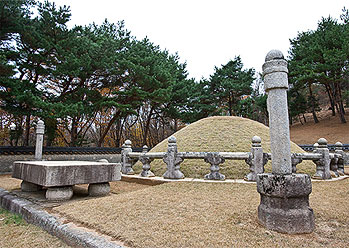 【 Photo: Changneung Royal Tomb 】
【 Photo: Changneung Royal Tomb 】 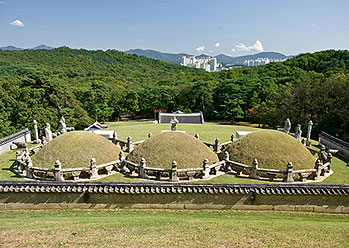 【 Photo: Gyeongneung Royal Tomb 】
【 Photo: Gyeongneung Royal Tomb 】
The site of West Five Royal Tombs in Goyang is the second largest royal burial site of the Joseon dynasty after the East Nine Royal Tombs in Guri. The tombs include Myeongneung, Gyeongneung, Changneung, Ingneung and Hongneung. The first tomb placed here was Gyeongneung, the resting place of King Sejo’s first son, Crown Prince Uigyeong (1438-1457) who died at an early age due to a disease.
The East Nine Royal Tombs are located in Guri, Gyeonggi-do and this site features the largest cluster of Joseon royal tombs. There are 17 kings and queens interred at this location. Gyeongneung Royal Tomb is especially worth noting due to the one-of-a-kind tomb of Samyeonneung, where King Heonjong (1827-1849) was entombed with two wives.
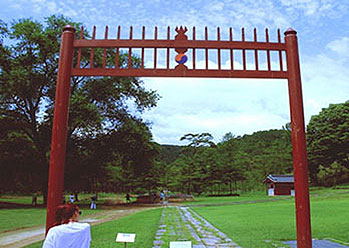 【 Photo: Jangneung's Hongsalmun Gate 】
【 Photo: Jangneung's Hongsalmun Gate 】 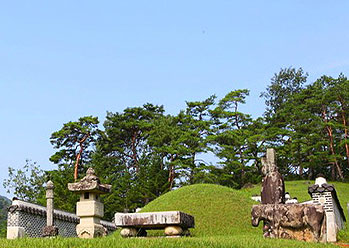 【 Photo: Jangneung Royal Tomb in Yeongwol 】
【 Photo: Jangneung Royal Tomb in Yeongwol 】
Jangneung is the tomb of Danjong, the 6th king of Joseon (1441-1457) whose throne was abdicated by his uncle. Leaving the royal palace upon exile, the king spent the remaining years of his life in Yeongwol. It was here that he was buried, far away from the capital. However, despite the distance, Jangneung is one of the most visited of all the royal tombs.
- Nearby attractions
Bongeunsa Temple
Bugaksan Mountain
Bukhansanseong Fortress
Yeongwol Cheongnyeongpo Meandering Stream - Website: royaltombs.cha.go.kr (Korean, English, Japanese, Chinese)
- 1330 Korea Travel Hotline: +82-2-1330 (Korean, English, Japanese, Chinese, Russian, Vietnamese, Thai, Malay)
Historic Villages of Korea: Hahoe and Yangdong (Designated 2010)
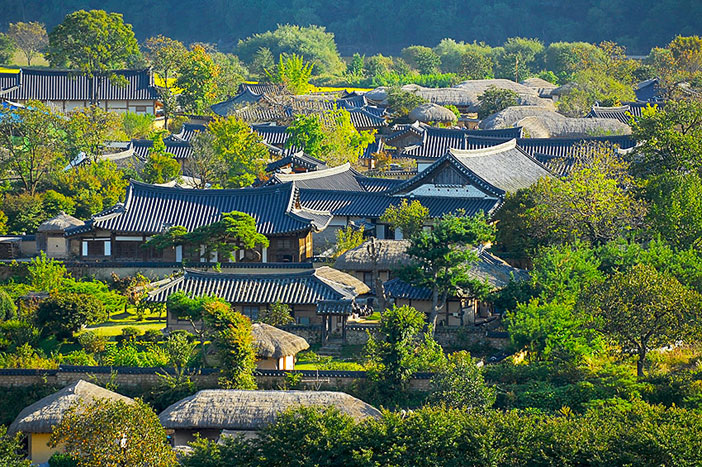 【 Photo: Andong Hahoe Village 】
【 Photo: Andong Hahoe Village 】 Andong Hahoe Village and Gyeongju Yangdong Village are historical villages that were developed during the 14th to 15th century in Gyeongsangbuk-do. These two villages are well-preserved examples of typical Korean clan villages based on descents whose members carry the same family name derived from common ancestors. Even today, these families live in the village and continue their meaningful legacy, making the whole village a living and active cultural heritage.
The villages clearly exhibit the typical Confucian culture of the Joseon period, where there was a distinct line between the aristocratic yangban class and commoners. The arrangement of the dwellings shows how village life was regulated and strictly enforced. The head of the clan in addition to the yangban class resided in wooden housing with their own pavilions, lecture halls and shrines while the commoners lived in houses made of soil with straw roofs.
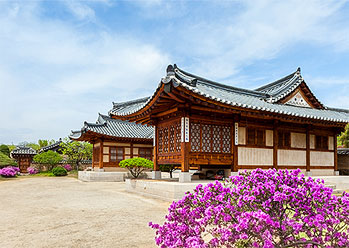 【 Photo: Andong Hahoe Village 】
【 Photo: Andong Hahoe Village 】 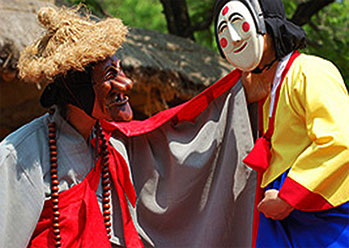 【 Photo: Mask Dance Drama of Hahoe 】
【 Photo: Mask Dance Drama of Hahoe 】
Near the end of the Goryeo period, Hahoe Village was home to the Heo, Ahn, and Ryu clans, but over time only the Ryu clan remained. The tradional image of Korea is well preserved here, and is internationally famous, having been visited by Queen Elizabeth II of England in 1999, her son Prince Andrew in 2019, and George H.W. Bush, the former president of the United States in 2005.
Hahoe Village features the dwellings and lecture halls of the yangban class, and the various types of houses lived in by commoners. In addition to the architecture, traditional performances like Hahoe Byeolsingut Tallori (Mask Dance Drama of Hahoe) and Seonyujul Bullori (Seonyu Roap Fire Play) have continued until modern times.
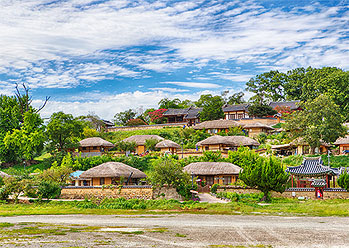 【 Photo: Gyeongju Yangdong Village 】
【 Photo: Gyeongju Yangdong Village 】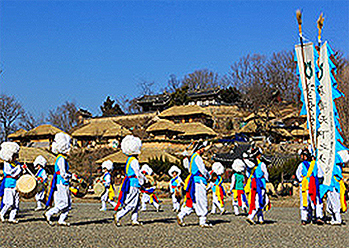 【 Photo: Traditional performance 】
【 Photo: Traditional performance 】
Gyeongju Yangdong Village is Korea’s largest traditional village. The aristocratic yangban class lived in tile-roofed houses, mostly on high hills, while the commoners typically lived in thatched-roof houses at the foot of the hills. The village is well organized and clearly sectioned by the purpose and usage of the buildings.
Located at the entrance of the village, Yangdong Village Cultural Center exhibits artifacts that help explain the history of the village. Visitors can also take part in a variety of hands-on traditional cultural programs.
- Nearby attractions
Woryeonggyo Bridge
Dosanseowon Confucian Academy
Andong Folk Museum
Bulguksa Temple
Seokguram Grotto
Hwangnyongsa Temple Site
Gyeongju National Museum - Website: www.hahoe.or.kr (Korean, English, Japanese, Chinese, French, German)
- 1330 Korea Travel Hotline: +82-2-1330 (Korean, English, Japanese, Chinese, Russian, Vietnamese, Thai, Malay)
Namhansanseong Fortress (Designated 2014)
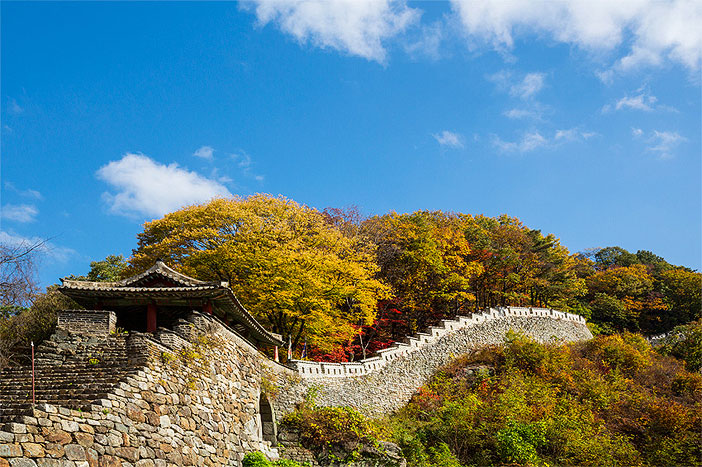 【 Photo: Namhansanseong Fortress 】
【 Photo: Namhansanseong Fortress 】 Namhansanseong Provincial Park was originally a unique fortress city of the Joseon period which functioned as an emergency capital. Built in the early 7th century, the well-preserved castellation techniques, which were influenced by the styles of China and Japan, greatly raise the historical and cultural values of the fortress.
The fortress has four gates and mullu (2-story houses built atop the gates) in the north, south, east, and west directions. Major cultural assets within the fortress include Sueojangdae Post, Janggyeongsa Temple, haenggung (temporary palace), Sungnyeoljeon Shrine, and Cheongnyangdang Shrine.
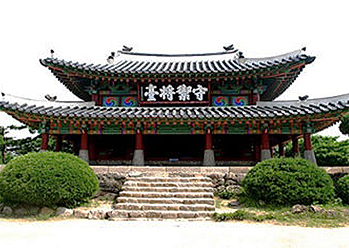 【 Photo: Sueojangdae Post 】
【 Photo: Sueojangdae Post 】
(Credit: Cultural Heritage Administration)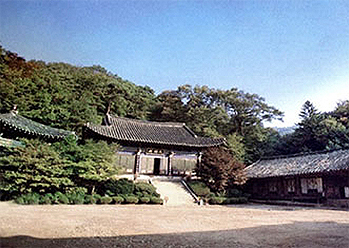 【 Photo: Janggyeongsa Temple 】
【 Photo: Janggyeongsa Temple 】
(Credit: Cultural Heritage Administration)
Out of 4 posts erected, Sueojangdae Post is the only remaining structure and sits at the peak of Iljangsan Mountain, the highest point of the fortress. King Injo himself helped to direct and encourage the troops from here during the Manchu War of 1636. They were able to hold out for 45 days.
Janggyeongsa Temple, built in 1683, was where the monks who were helping to build the fortress stayed. The temple is a cultural asset showing the great dedication the monks of Joseon era had in serving their nation. The temple is the only place that was preserved out of the nine temples that were built by the Buddhist Army, known as Seunggun in Korean.
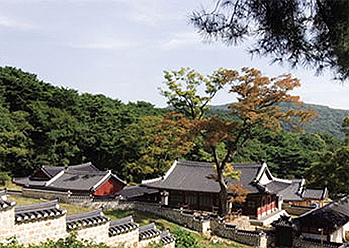 【 Photo: Temporary Palace at
【 Photo: Temporary Palace at
Namhansanseong Fortress 】
(Credit: Cultural Heritage Administration)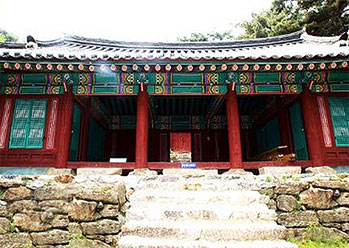 【 Photo: Sungnyeoljeon Shrine 】
【 Photo: Sungnyeoljeon Shrine 】
(Credit: Cultural Heritage Administration)
The temporary palace at Namhansanseong Fortress was constructed to serve as a shelter for the royal family and an emergency capital city during wartimes. Unlike other temporary palaces, it was a self-sufficient defensive fortress where the local administrative center was placed within the fortress along with a royal ancestral shrine and altar.
Sungnyeoljeon Shrine was built in commemoration of the founder of the Baekje Kingdom, King Onjo and General Yi Seo, who was in charge of the construction of the fortress. These two leaders are enshrined together here, and sacrificial rites are held to their spirits whenever there are big events related to the fortress.
- Nearby attractions
Korean Folk Village
Seoul Grand Park
Hwaseong Fortress
Gwangju Gonjiam Ceramics Park - Website: www.gg.go.kr/namhansansung (Korean only)
- 1330 Korea Travel Hotline: +82-2-1330 (Korean, English, Japanese, Chinese, Russian, Vietnamese, Thai, Malay)
Baekje Historic Areas (Designated 2015)
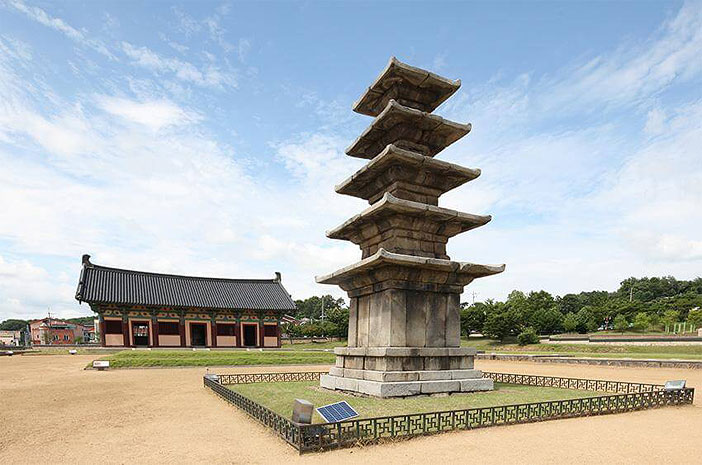 【 Photo: Five-story Stone Pagoda at Jeongnimsa Temple Site 】
【 Photo: Five-story Stone Pagoda at Jeongnimsa Temple Site 】 Tracing the relics of Baekje from Iksan in Jeollabuk-do, and Buyeo and Gongju in Chungcheongnam-do, one can catch a glimpse of the ancient kingdom. The palaces and temple sites of Baekje Historic Areas bring to life the most flourishing times of Baekje.
Baekje Historic Areas have garnered international recognition for their value in showing the trade and cultural exchange with other countries such as China and Japan. The area constitutes eight important cultural heritage sites that spread across the cities of Gongju, Buyeo and Iksan. Gongsanseong Fortress and Ancient Tombs in Songsan-ri are located in Gongju, while the four sites of Archaeological Site in Gwanbuk-ri and Busosanseong Fortress, Ancient Tombs in Neungsan-ri, Jeongnimsa Temple Site, and Buyeo Outer City Wall are found in Buyeo. Archaeological Site in Wanggung-ri and Mireuksa Temple Site are located in Iksan.
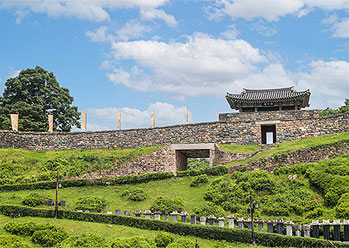 【 Photo: Gongsanseong Fortress 】
【 Photo: Gongsanseong Fortress 】 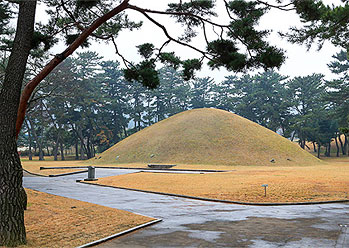 【 Photo: Tomb of King Muryeong 】
【 Photo: Tomb of King Muryeong 】
Gongju Gongsanseong Fortress was called Ungjinseong Fortress in the Baekje Era and later became known as Gongsanseong after the Goryeo dynasty. The fortress stretches from Gongsan Moutain's summit to a smaller peak to the west. Gongsanseong Fortress not only has historical value but also a stunning night view.
The Royal Tomb of King Muryeong is the tomb of the 25th king of Baekje and his queen. It is one of very few ancient tombs in which the occupants have been identified. The tomb remained perfectly intact until it was discovered, leading to the excavation of over 4,600 artifacts. The tomb holds great historical value and become a large asset to the study of art history.
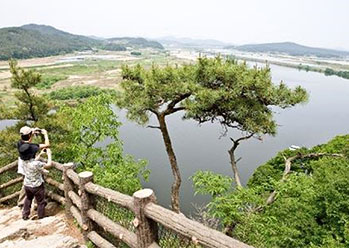 【 Photo: Nakhwaam Rock in Busosanseong Fortress 】
【 Photo: Nakhwaam Rock in Busosanseong Fortress 】 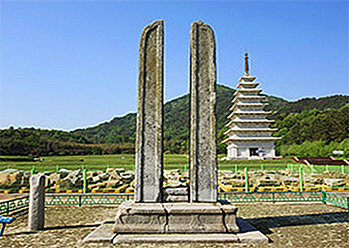 【 Photo: Flagpole supports at Mireuksa Temple Site 】
【 Photo: Flagpole supports at Mireuksa Temple Site 】
Busosanseong Fortress, which used to be called Sabiseong, was the capital of Baekje of the kingdom’s final 123 years. The fortress is known for Nakhwaam Rock, which literally means “Rock of Falling Flowers,” a rock cliff where 3,000 ladies of the court jumped to their deaths at the downfall of their kingdom.
Mireuksa Temple Site features the remains of what was the largest temple in the history of Baekje, famous for its pagoda and flagpole supports. The Stone Pagoda at Mireuksa Temple Site is the oldest and the largest stone pagoda in Korea. The eastern pagoda was restored in 1992 and restoration of the west pagoda was completed in 2018. In particular, the flagpole supports of Mireuksa Temple Site are held as a great cultural heritage for being well preserved.
- Nearby attractions
Magoksa Temple
Archaeological Site in Seokjang-ri, Gongju
Gongju National Museum
Seodong Park and Gungnamji Pond
Baekje Cultural Land
Seodongyo Theme Park - Website: www.baekje-heritage.or.kr (Korean, English, Japanese, Chinese)
- 1330 Korea Travel Hotline: +82-2-1330 (Korean, English, Japanese, Chinese, Russian, Vietnamese, Thai, Malay)
Sansa, Buddhist Mountain Monasteries in Korea (Designated 2018)
 【 Photo: Buseoksa Temple in Yeongju, Gyeongsangbuk-do 】
【 Photo: Buseoksa Temple in Yeongju, Gyeongsangbuk-do 】 Sansa are Buddhist mountain monasteries located throughout Korea. Seven temples – Tongdosa Temple, Buseoksa Temple, Bongjeonsa Temple, Beopjusa Temple, Magoksa Temple, Seonamsa Temple and Daeheungsa Temple - were recognized by UNESCO.
In the past, Korean temples consisted of both flatland temple sites and mountain temple sites. However, during the Joseon dynasty, most of the flatland temples were removed, leaving only the mountain monasteries remaining today. UNESCO rated the temples as having outstanding universal value thanks to their preservation of the traditional aspects of Korean Buddhist temples, serving as living centers of faith and daily practice. These seven temples include many individual characteristics as well as notable features that can only be seen in Korea's monasteries. The temples are praised for their authentic value in aspects of durability, historical significance, location and setting, and purpose.
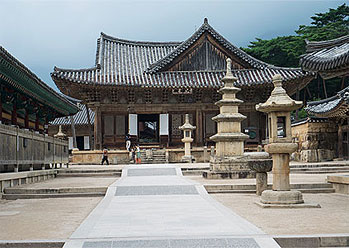 【 Photo: Tongdosa Temple 】
【 Photo: Tongdosa Temple 】 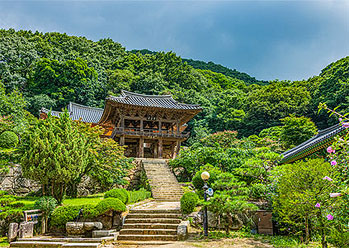 【 Photo: Buseoksa Temple 】
【 Photo: Buseoksa Temple 】
Tongdosa Temple was founded in 646 during the reign of Silla Queen Seondeok. One unique characteristic of this temple is that the statue of Buddha is not immediately visible when entering Yeongsanjeon Hall; the Buddha here is placed on the eastern part of the hall. The Buddha is surrounded by Palsangdo, Paintings of the Eight Great Events, a precious material in Buddhist artwork. The main hall, Daeungjeon Hall, also has no image of Buddha but does have an ordination platform, a type of Buddha reliquary.
Buseoksa Temple was founded in 676 during the 16th year of Silla King Munmu's reign. The temple is famous for it's staircase of 108 steps, designed to clear one's mind of any conflicts, a core component of Buddhism. Buseoksa Temple is home to Muryangsujeon Hall, one of the oldest wooden buildings in the nation. Another interesting structure at this temple is the Baeheullimgidung Pillar, which becomes narrower towards its peak.
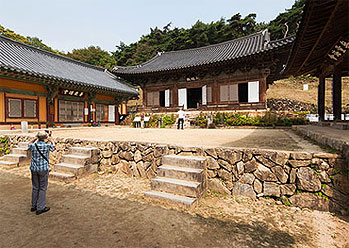 【 Photo: Bongjeongsa Temple 】
【 Photo: Bongjeongsa Temple 】 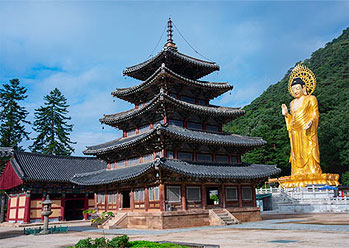 【 Photo: Beopjusa Temple's Gilt-bronze Maitreya
【 Photo: Beopjusa Temple's Gilt-bronze Maitreya
Buddha 】
Bongjeongsa Temple was built in 672 during the 12th year of Silla King Munmu's reign. Before entering the temple grounds, visitors must pass through Manseru, a building with no doors or walls. The entrance is small, requiring all who enter to lower their heads, a gesture of humbling oneself as taught in Buddhist culture. Bongjeongsa Temple is home to many historical treasures, including National Treasure Geungnakjeon Hall, known to be the oldest wooden building in Korea, and National Treasure Daeungjeon Hall.
Beopjusa Temple was founded in 553 during the 14th year of Silla King Jinheung's reign. The temple is home to the nation's only wooden pagoda, Palsangjeon Hall, as well as many other cultural heritages. The thing that draws the eye most is the 33-meter Gilt-bronze Maitreya Buddha statue. Many tourists come to see this grand statue, which used more than 100 tons of bronze.
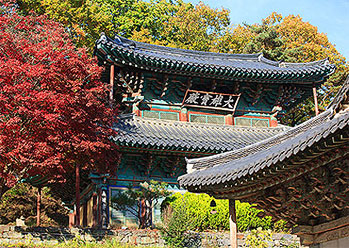 【 Photo: Magoksa Temple 】
【 Photo: Magoksa Temple 】 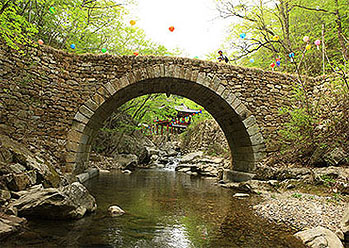 【 Photo: Seungseongyo Bridge of Seonamsa Temple 】
【 Photo: Seungseongyo Bridge of Seonamsa Temple 】
Magoksa Temple was founded in 640 during the 41th year of Baekje King Mu's reign, according to the temple's records. Thanks to the nearby flowing water and the peaceful mountain forest, the temple has a unique ambience of its own. It is also noteworthy that the flowing water and the mountains surrounding the temple form a taegeuk shape, a symbol of balance. During times of war, Magoksa Temple was used as a shelter. King Sejo commended the temple, saying it would last for over ten thousand years, and even wrote the signboard for Yeongsanjeong Hall himself. The hall later burned down during the Imjin War (1592-1598), but was rebuilt in 1650, and is currently the oldest building within Magoksa Temple.
Seonamsa Temple was built in 529 during the 3rd year of Silla King Jinheung's reign. The path to the temple features the arched Seungseongyo Bridge and an apricot tree over 600 years old. Many tourists come to see the beautiful harmony created among the bridge, valley, and forest. Seonamsa Temple is unique in that there is no gate of Four Guardian Kings which is normally found in temples. There is also only one statue of Buddha, located within Daeungjeon Hall, and there is no central door to the hall.
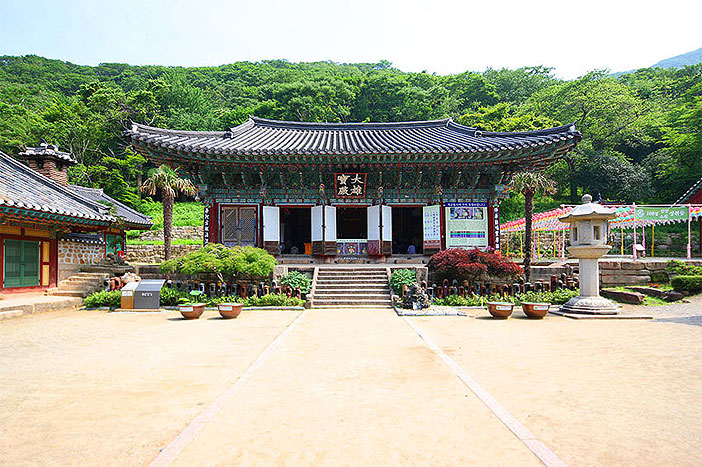 【 Photo: Daeheungsa Temple 】
【 Photo: Daeheungsa Temple 】 Daeheungsa Temple was built sometime before the Goryeo dynasty but its exact date of construction remains unknown. It holds strong commitment to the preservation of the nation through Buddhist faith, with many important Buddhist monks and scholars having come from this temple. It also served an important role in establishing Korea's tea culture. The temple is quite large, spread out into three major areas on the mountainside.
- Nearby attractions
Yeongju Museom Village
Andong Hahoe Village
Boeun Fun Park
Gongju Jungdong Catholic Church
Suncheonman Bay Wetland Reserve
Haenam Dinosaur Museum - Websites
Tongdosa Temple www.tongdosa.or.kr (Korean, English)
Beopjusa Temple beopjusa.org (Korean, English)
Magoksa Temple www.magoksa.or.kr (Korean, English) - 1330 Korea Travel Hotline: +82-2-1330 (Korean, English, Japanese, Chinese, Russian, Vietnamese, Thai, Malay)
Seowon, Korean Neo-Confucian Academies (Designated 2019)
 【 Photo: Dosanseowon Confucian Academy 】
【 Photo: Dosanseowon Confucian Academy 】 Korea's Confucian Academies, called seowon in Korean, were built throughout the 16th and 17th centuries. They served as schools for scholars to study and improve by following Confucian principles. There are many of these centers of education throughout Korea, with UNESCO recognizing Sosuseowon Confucian Academy, Namgyeseowon Confucian Academy, Oksanseowon Confucian Academy, Dosanseowon Confucian Academy, Piramseowon Confucian Academy, Dodongseowon Confucian Academy, Byeongsanseowon Confucian Academy, Museongseowon Confucian Academy, and Donamseowon Confucian Academy. These nine sites are exemplary in their universal value, promoting and continuing traditional culture.
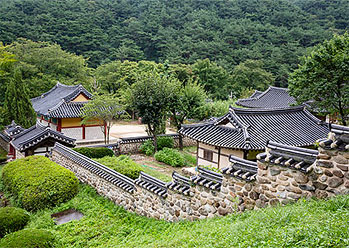 【 Photo: Sosuseowon Confucian Academy 】
【 Photo: Sosuseowon Confucian Academy 】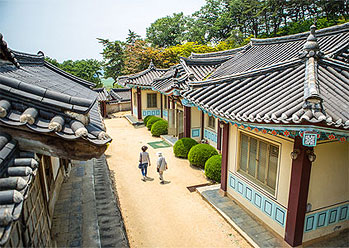 【 Photo: Dosanseowon Confucian Academy 】
【 Photo: Dosanseowon Confucian Academy 】
Sosuseowon Confucian Academy was the first of these schools in Korea. It received support from the nation as an official academy of learning, with the academy signboard coming as a gift from the king. It was founded under mid-Joseon dynasty Confucian scholar Ju Se-bung (1495-1554). This academy is unique for placing the two study buildings of Jikbangjae Hall and Ilsinjae Hall together.
Dosanseowon Confucian Academy was established in 1574 to honor Toegye Yi Hwang, one of the nation's most important scholars. The academy features simple, humble buildings that were designed to help scholars focus on the teachings and works of Toegye Yi Hwang. The academy consists of a lecture hall, located at the center of the premises; a shrine, and annex buildings.
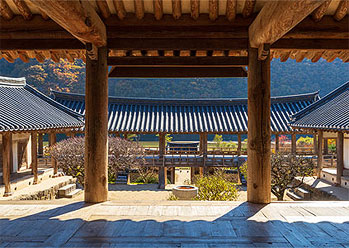 【 Photo: Byeongsanseowon Confucian Academy 】
【 Photo: Byeongsanseowon Confucian Academy 】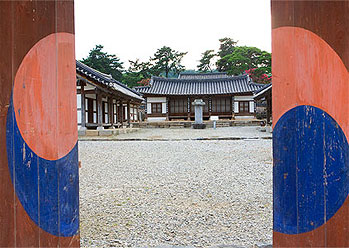 【 Photo: Donamseowon Confucian Academy 】
【 Photo: Donamseowon Confucian Academy 】
Byeongsanseowon Confucian Academy originally started during the Goyreo era as Pungakseodang School. It was renamed Byeongsanseowon when the school was moved to the current location in Andong. It is a prime example of the early style of construction for Confucian academies, with a lecture hall, memorial hall, student dormitories, and a dining hall. The school overlooks the Nakdonggang River, showing a strong harmony with the surrounding nature.
Donamseowon Confucian Academy was founded by Sagye Kim Jangsaeng (1548-1631). The name was given in 1660 by King Hyeonjong (1641-1674). These nine UNESCO-designated seowon are just some of the few Confucian academies that survived the seowon purge led by Heungseon Daewongun.
- Nearby attractions
Seonbichon Village
Hahoe Mask Museum
Hong Gil-dong Theme Park
Baekje Military Museum
Sunshine Land
Tapjeongho Lake - Websites
Dosanseowon Confucian Academy: www.dosanseowon.com (Korean, English, Japanese, Chinese)
Byeongsanseowon Confucian Academy: www.byeongsan.net (Korean only)
Donamseowon Confucian Academy: www.donamseowon.co.kr (Korean only) - 1330 Korea Travel Hotline: +82-2-1330 (Korean, English, Japanese, Chinese, Russian, Vietnamese, Thai, Malay)
This page was last updated on October 5, 2021, and therefore information may differ from what is presented here.
